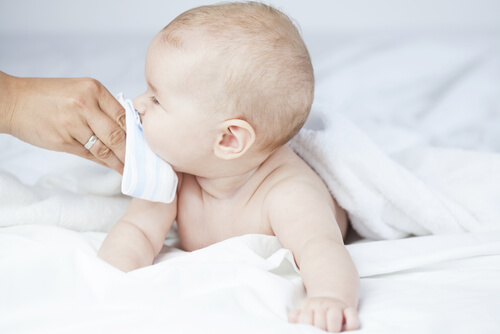How to Decongest a Baby's Nose

Do you know how to decongest a baby’s nose? Here we’ll explain how to correctly do it step by step.
Nasal congestion can cause babies to feel uncomfortable and have difficulty eating or sleeping. This problem is very common and can be caused by allergies or the flu.
In addition, babies are more likely to get viruses than adults.
How to decongest a baby’s nose with a rubber bulb
Nasal aspiration is a very useful and easy way to decongest a baby’s nose. To do it, you only need a rubber bulb, saline solution (which can be prepared at home or bought directly from a pharmacy) and a tissue.
Learn how to decongest a baby’s nose by following these steps:
- Lay the baby on his back. On each side, give one or two drops of saline solution. If you prefer to prepare it at home, you only need to mix a teaspoon of salt in a cup of warm water.
- Allow the saline solution to act for a few seconds. When you lift the baby, the mucus should come out on its own. If it doesn’t, you can use the nasal bulb.
- Press the nasal aspirator into the nostril gently but firmly. In order for it to function properly, you must insert it into the baby’s nose and suck the mucus out. Don’t be afraid to put it in. The baby’s nostrils are quite deep and if you don’t place it in well, you won’t suck anything out.
- Empty the bulb by squeezing it, and use a tissue to wipe around the nose. To clean the bulb, use soap water and place it upside down to dry.

Other tips for decongesting a baby’s nose
There are other quite practical and less intrusive ways to decongest a baby’s nose.
It’s important to emphasize that you should only decongest a baby’s nose if it’s strictly necessary, such as when a greenish mucus is seen. If you’re unsure, just give saline solution two or three times a day.
Humidifier
One of the best ways to decongest the nose is through water vapor. You shouldn’t apply it directly to the face, because it can cause very serious burns.
An electric humidifier is used to maintain a humid environment, in which mucus is easier to expel.
Never use a cotton swab to clean a baby’s nose.
Saline spray
Some saline sprays are very effective at decongesting babies’ noses and can be used to hydrate the nasal passages, which can dry out due to arid climates.
Although it’s simple to use, some may contain ingredients that aren’t suitable for babies. Therefore, it’s important to always consult a pediatrician.

How to avoid nasal congestion
First, it’s advisable to continue breastfeeding, since newborns receive immune protection from it. It’s also very important to discover the cause of nasal congestion, because this will influence the treatment.
Here are some tips to avoid nasal congestion in babies:
- The room where the baby sleeps should be ventilated and clean of dust.
- Adults shouldn’t smoke in the baby’s presence.
- The room environment shouldn’t be too dry or too humid.
- If you have a humidifier in the room, keep it clean so it doesn’t grow mold, as this would only make the baby’s congestion worse.
- Don’t use chemical air fresheners or cleaning products that are too strong, because they can cause an allergic reaction.
- Pet hair can also cause allergies
- Avoid air conditioners and heaters. Air conditioning causes the environment to be dry, but the use of an electric fan can also be a problem. An electric humidifier can help you increase the humidity in the air.
Now that you know how to decongest your baby’s nose, you must have a lot of patience. This can be a very unpleasant problem for him.
Always clean his nose slowly and with great care. It’s best to do it before breastfeeding in order to help him eat well, or before sleeping so he doesn’t wake up in discomfort.
Don’t forget about having him drink enough water if he’s old enough, as this will help prevent nasal congestion.
All cited sources were thoroughly reviewed by our team to ensure their quality, reliability, currency, and validity. The bibliography of this article was considered reliable and of academic or scientific accuracy.
- Chirico G, Quartarone G, Mallefet P. Nasal congestion in infants and children: a literature review on efficacy and safety of non-pharmacological treatments. Minerva Pediatr. 2014 Dec;66(6):549-57. PMID: 25336097. Disponible en: https://pubmed.ncbi.nlm.nih.gov/25336097/
- Chirico G, Beccagutti F. Nasal obstruction in neonates and infants. Minerva Pediatr. 2010 Oct;62(5):499-505. PMID: 20940683. Disponible en: https://pubmed.ncbi.nlm.nih.gov/20940683/
- The Children’s Mercy Hospital (2020) Cómo usar un aspirador nasal manual. [Internet]. Disponible en: https://www.childrensmercy.org/siteassets/media-documents-for-depts-section/documents-for-health-care-providers/evidence-based-practice/clinical-practice-guidelines–care-process-models/manual-nasal-aspirator-spanish.pdf
This text is provided for informational purposes only and does not replace consultation with a professional. If in doubt, consult your specialist.








